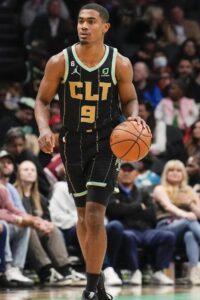The action on the NBA’s free agent market has slowed since the start of July, but there are still many FAs seeking new deals, including a notable group of under-the-radar players whose situations will need to be resolved in the coming days, weeks, and months.
A total of 12 two-way restricted free agents are still available, as our up-to-date list shows. Those players are as follows:
- Trent Forrest (Hawks)

- Theo Maledon (Hornets)
- Terry Taylor (Bulls)
- Lester Quinones (Warriors)
- Kendall Brown (Pacers)
- Jamal Cain (Heat)
- Matt Ryan (Timberwolves)
- Trevor Keels (Knicks)
- Duane Washington (Knicks)
- Dominick Barlow (Spurs)
- Jeff Dowtin (Raptors)
- Ron Harper Jr. (Raptors)
That group doesn’t include a 13th player, Neemias Queta, who is also a restricted free agent after finishing last season on a two-way deal. Although he remains eligible to sign another two-way contract, Queta was ineligible for a two-way qualifying offer after having played on a two-way with the Kings for consecutive seasons — his QO is a one-year, minimum-salary contract with a small ($75K) partial guarantee.
For the rest of these players, their qualifying offer is simply another one-year, two-way deal, which limits their leverage to negotiate a more lucrative standard contract.
Some two-way RFAs have managed to earn standard deals this offseason. A.J. Green of the Bucks was one. Julian Champagnie of the Spurs was another. Ty Jerome (Warriors) and Jack White (Nuggets) received standard contract offers from the Cavaliers and Thunder, respectively, that their former teams were unwilling to match, so Golden State and Denver simply withdrew their respective qualifying offers, making Jerome and White unrestricted free agents.
Offer sheets for two-way restricted free agents essentially never happen though. And in general, unless a team has earmarked a 15-man roster spot for a two-way free agent, it’s an uphill battle for these players to earn offseason promotions.
As a result, the majority of the dozen restricted free agents listed above will likely end up accepting their qualifying offers and hoping that their play in 2023/24 forces their clubs to find 15-man roster spots for them later in the season.
Still, it’s worth keeping an eye on this group to see if any of them can do better than another two-way — and to see how long some of them might be willing to wait in the hope of earning that opportunity.
Quiñones and Barlow are clearly better than a two way contract, in my opinion. I have no idea why another team wouldn’t offer them a standard contract on their 15 man spot. I don’t think it’s a slam dunk that GS (luxury tax) or San Antonio (roster full) would match the offer.
Dowtin Abbey…get it?
Josh Lloyd joke
6-7 solid nba role players on this list that deserve to stick
The Warriors really can’t match anything over the league minimum. For the Spurs it’s a numbers game. They had 18 players on standard contracts not including 2-way deals. They have to shed at least 3 of these guys. Yesterday they released Lamar Stevens. But will need to dump 2 more guys. Barlow will either be renewed on his 2-way deal or let go. For him to upgrade he’ll have to change teams.
Barlow, while his handle is still loose and too high
Has tightened all other facets of his young game
Coming on strong here year 2
I like Theo and Queta